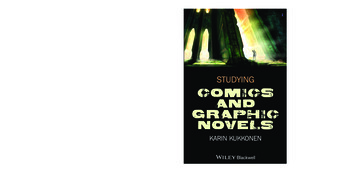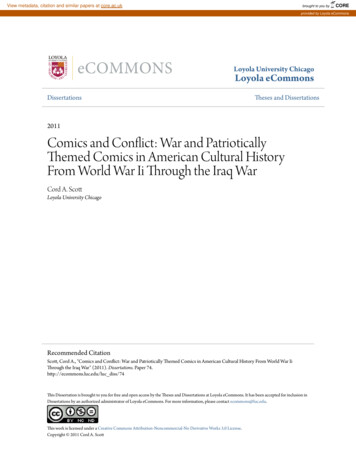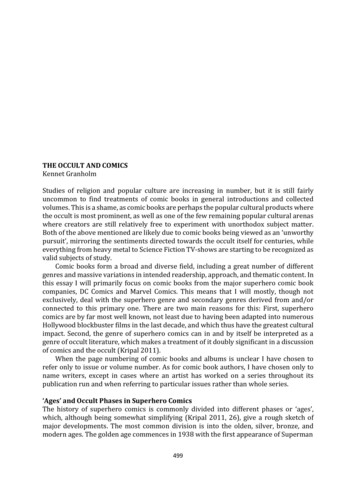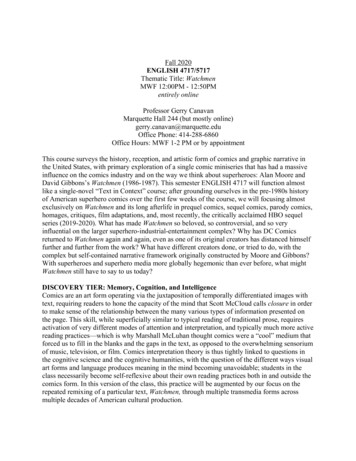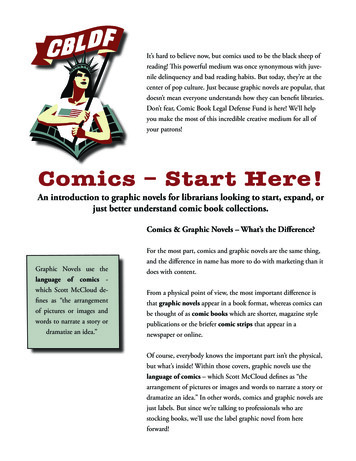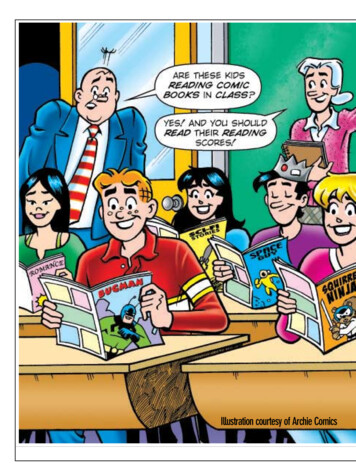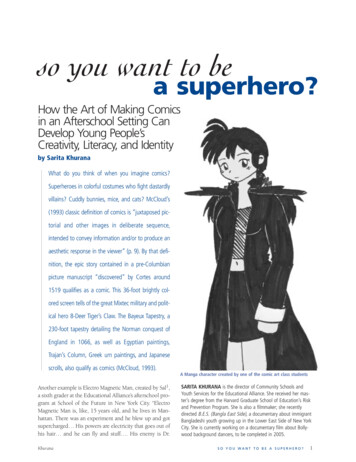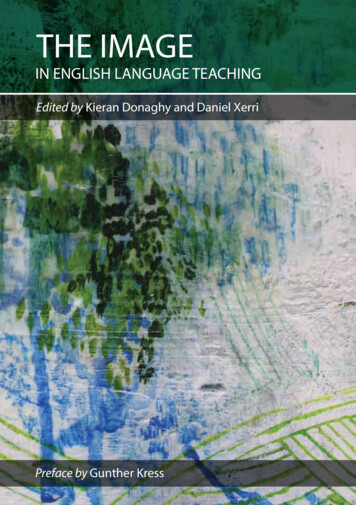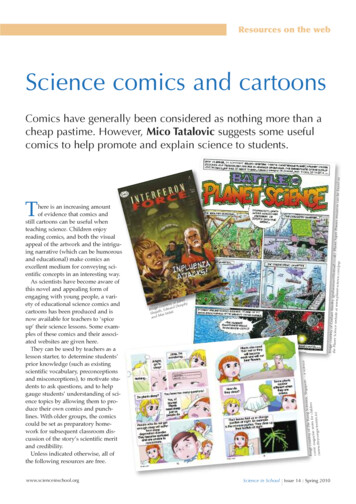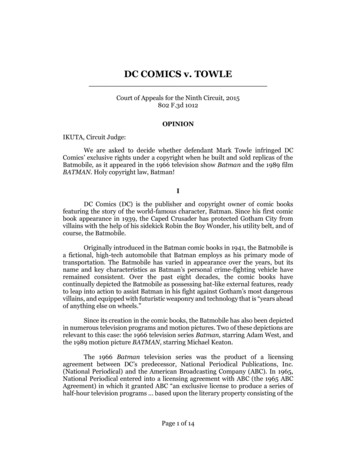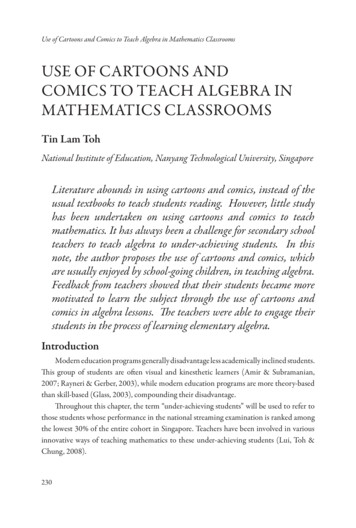
Transcription
Use of Cartoons and Comics to Teach Algebra in Mathematics ClassroomsUSE OF CARTOONS ANDCOMICS TO TEACH ALGEBRA INMATHEMATICS CLASSROOMSTin Lam TohNational Institute of Education, Nanyang Technological University, SingaporeLiterature abounds in using cartoons and comics, instead of theusual textbooks to teach students reading. However, little studyhas been undertaken on using cartoons and comics to teachmathematics. It has always been a challenge for secondary schoolteachers to teach algebra to under-achieving students. In thisnote, the author proposes the use of cartoons and comics, whichare usually enjoyed by school-going children, in teaching algebra.Feedback from teachers showed that their students became moremotivated to learn the subject through the use of cartoons andcomics in algebra lessons. The teachers were able to engage theirstudents in the process of learning elementary algebra.IntroductionModern education programs generally disadvantage less academically inclined students.This group of students are often visual and kinesthetic learners (Amir & Subramanian,2007; Rayneri & Gerber, 2003), while modern education programs are more theory-basedthan skill-based (Glass, 2003), compounding their disadvantage.Throughout this chapter, the term “under-achieving students” will be used to refer tothose students whose performance in the national streaming examination is ranked amongthe lowest 30% of the entire cohort in Singapore. Teachers have been involved in variousinnovative ways of teaching mathematics to these under-achieving students (Lui, Toh &Chung, 2008).230
Tin Lam TohTeachers may be more successful in their lesson delivery if they are more conscious ofthe different learning styles of their students and attempt to use different teaching methodsfor different types of students (Myron & Keith, 2007). This is especially important whenteachers are teaching abstract topics like algebra.The reason why this paper places the emphasis on algebra is that there is a worldwidepush to make algebra a required part of most mathematics curricula in the world. Accordingto NCTM use expanded form of NCTM for first use, students are required to have strongbackground in algebra by Grade 8 (NCTM, 2000).NCTM (2000) suggests that algebraic concepts need to be presented in a context thatis meaningful to students. However, in schools, anecdotal evidence suggests that algebrais not usually presented in a meaningful or interesting way, causing students not to enjoylearning the subject.For more than five years, mass communication research has raised exciting ideas on howthe commercial world has managed to tap on cartoons and comics successfully to attractteenagers to commercial products. This is the genesis of the idea of linking cartoons andcomics to mathematics education: since most students in schools enjoy reading cartoonsand comics, why not use them in teaching mathematics? In this paper, the author proposesthe use of cartoons and comics in teaching algebra in the secondary school curriculum.Cartoons, Comics and AlgebraCartoons and comics have traditionally been seen as “enemies” of the schools; studentscaught reading comics in schools were likely to be disciplined (Cleaver, 2008). However,today, some teachers are beginning to view comics as potential educational tools, as a wayto arouse students’ interest in academic subjects (Cleaver, 2008), and also an avenue toimprove their students’ academic literacy (Tilley, 2008).While reading comics can never approach the complexity of reading ‘real’ texts,“compared to reading ‘real’ books, reading comics appears to be a simple task and comparedto reading no books, reading comics might be preferable” (Tilley, 2008).Research has provided evidence that cartoons and comics have particular attraction amongschool age children (Wright & Sherman, 2006). Students are generally at ease in combiningvisual and text information in reading comics. The use of comics in teaching can thus provideopportunities for skill-building, creativity and reading for content (Urbani, 1978).Research highlights particular difficulties which students find in learning schoolalgebra? According to Lee (2007, pp 34 – 35), the difficulties can be broadly classifiedunder three main categories:231
Use of Cartoons and Comics to Teach Algebra in Mathematics Classrooms Students are not familiar with the syntax of algebra; Students are confused over the different uses of letters in algebra; Students find algebraic procedures too abstract.Difficulties occurred in students’ learning of algebra because of their wronginterpretation of algebraic objects (Kirshner, 1989). The wrong interpretation appearedto have resulted from the visual presentation of the algebraic objects. Kirshner (1989)suggested that algebraic skills developed not only from learning or practising explicit rulesbut also from recognising visual patterns on printed pages.Teachers may also contribute to part of the misconceptions in the students’ mind aboutthe learning of algebra (Baroudi, 2006), if their emphasis in teaching algebra is placed solelyon the computation and the procedural processes of algebra. This is especially true whenteachers do not strive to achieve in their students a relational understanding of the algebraicoperations (Knuth, Alibali, McNeil, and Weinberg, 2005, p69).Therefore the author, who is currently involved in the mathematics education programin Singapore and was previously involved in the writing of mathematics textbooks forunder-achieving mathematics students in Singapore, entertained the idea of using cartoonsand comics in teaching mathematics. The author “sold” this idea to a few practising teachers(hereafter called “the teachers”), and informally convinced them to try out the idea ofinfusing cartoons and comics into teaching algebra before the textbooks were officiallylaunched. The following sections describe the ideas that were “sold” to the teachers, andtheir feedback about the approach after experimenting with their students.Welcome to the World of Algebra!Students generally prefer to communicate via non-algebraic representations (Neria andAmit, 2004). The use of numbers generalized by letter designations raises difficulties formost students (Hembree, 1992). However, one has to first learn the “language” of algebraas the crucial first step to learning algebra.According to the mere exposure theory of communication, simple repeated exposure tothe communication can influence attitudes, provided that the people have not developednegative feeling to the “message” (Zajonc, 1968). The author suggests that repeatedexposure of students to cartoons and comics that demonstrate the use of the language ofalgebra can be used to introduce the students the world of algebra. This process of repeatedexposure will reduce the students’ fear with using letters to represent numbers. Examples ofcomic strips that can be used are shown in Figure 1.232
Tin Lam TohFigure 1. Comic strips used to familiarize students with the use of letters to represent numbers(Toh, Lim, Chua & Heng, 2007a, p253-254)However, the process of introducing algebra must be gradual. Successful learning ofalgebra has to be built upon students’ experience with arithmetic (Bednarz, 2001). Continuitybetween algebra and arithmetic can be achieved through a gradual “complexification ofreasoning procedures” (Bednarz, 2001). To achieve this, short comic strips can be introducedas activities for students to initiate them into using algebra languages.Introducing the language of AlgebraComic strips such as Figure 1 are used to introduce the language of algebra as“generalized arithmetic”. This is one approach to get the students inducted into the worldof algebra, and, even develop the habit of using algebra in their daily language! The authorstrongly encouraged the participating teachers to use these comic strips to begin introducingalgebra, instead of the routine way of introducing algebra from the classical textbooks basedon procedural approach.The teachers were also encouraged to use comic strips to lead their students to thinkmore deeply into the language of algebra, and in a more humorous way. For example,students can think of x 1, as “one more than x” instead of the usual arithmetic operationof addition of x and 1 (Figure 2).233
Use of Cartoons and Comics to Teach Algebra in Mathematics ClassroomsFigure 2. Another comic strip on the language of algebra (Toh et al, 2007a, p253).The teachers agreed that the under-achieving students generally prefer drawings.Instead of fighting a losing battle against banning drawings, the author encouraged theteachers to turn the students’ ‘talent’ in drawing to good learning opportunity in learningalgebra. The author further advocated to the teachers to incorporate drawing activities inintroductory algebra classes!Drawing Activities in Algebra ClassesThe teachers were urged to provide opportunities for their students to create their owncartoons and comic strips, using the language of algebra. A sample activity used by oneteacher is provided below.Choose two expressions below, draw cartoons for:(a) x – 1(b) y 10(c) x – y(d) 2x 1You can be as creative as possible. The most creative cartoon will win you asurprising prize!Figure 3. Sample activity used by a teacher in her introductory algebra lesson.234
Tin Lam TohFeedback from the TeachersThe teachers told the author that, through using cartoons and comics to introducealgebra, the students were less resistant to learning algebra. The teachers were able toengage more students to learn more challenging algebra (such as communicating in algebralanguage), involved in the addition and subtraction of algebraic expressions.By engaging the students to draw cartoons and comic strips (Figure 3) in the processof learning algebra, the under-achieving students were more willing to participate in thelessons through creating their own cartoons and infusing the algebraic language. Thelanguage of algebra also becomes more natural to them.When asked whether there was any potential problem in the use of the cartoons(Figures 1 and 2) for teaching, the teachers commented that Figure 1 was too “noisy” inthe use of language; many of the under-achieving students were also weak in language (theywere not native English speakers). The lengthy sentences in Figure 1 posed some difficultyto their students. Figure 2 was less wordy and more “humorous”, and that it brought outthe meaning of addition of x and 1, and developed the students’ understanding of x 1 as“one more than x”.What teachers learn from students’ cartoons?One teacher commented that the cartoons drawn by the students could also be used bythe teachers to assess the students’ understanding associated with the algebraic objects. Forexample, x – 1 and y 10 (activities from Figure 3) have brought across to the students theideas of “one less than x” and “ten more than y” respectively on top of the usual arithmeticoperations associated with the algebraic expressions.On the other hand, the cartoon drawn for “x – y” (Figure 3) shows the students’ [mis]understanding that x – y is always smaller than x. Although the students had already learntnegative numbers, they had a misconception that the letters represent some unknownpositive numbers, which is described as “incomplete concept image” (Tall and Vinner,1981). The development of such incomplete concept image would cause problems lateron when the students learn subtraction of negative numbers. Thus, observant classroomteachers could make use of students’ work to pre-empt the students’ misconceptions ofalgebraic objects, so as to better prepare their subsequent algebra lessons.235
Use of Cartoons and Comics to Teach Algebra in Mathematics ClassroomsSolving Algebraic EquationsStudents usually encounter difficulty with solving linear algebraic equations. Theirconceptual understanding of algebraic equations is not well developed because they arenot provided with opportunities to engage in enactive or iconic forms of the idea, whilethe symbolic version of algebra is beyond their grasp (Yeap, 2009, p 32). Students usuallysee an equation as an arithmetic process and unable to see it as an object to work on (Sfard,1991).Further, teachers have been using algebraic procedures like “cancel” and “bring over”in solving algebraic equations, which could have further contributed to the students’ errorsand difficulties with algebraic equations (Martinez, 1988).The author proposed the contextualization of a linear equation as balancing two sidesof a beam balance. The teachers could get their students to think of the physical processesof solving an equation. For example, consider Figure 4 in context: “James is asked to find theunknown weight x. How could you find the value of x?”Figure 4. Comic strip used to introduce the students to solving linear algebraic equation(Toh, 2008, p83)The above approach presents an equation as an object for students to work on: inFigure 4, one could remove the 3 kg watermelon on the left pan and 3 kg of rice from theright pan to balance both sides of the machine. Instead of rushing into solving x 3 9 inthe above case, the students are led to view an equation as an object to act on. Subsequently,teachers would be able to facilitate their students solving the more complicated situation inFigure 5, and to translate the problem into one involving a linear equation.236
Tin Lam TohAli is given a situation of balance of three bags of gold coins and fourseparate gold coins as shown above. Can you help him decide howmany gold coins are there in each bag?Figure 5. Using beam balance to solve the equation 2x 1 x 3 (Toh, 2007)Feedback from the TeachersThe teachers generally felt that this approach of solving linear equations helpstheir students more than the traditional approach of introducing the section on solvingalgebraic equations. It helps the students to move beyond the guess-and-check processes,and transcends the process of solely focusing on algebraic procedures. It helps studentsto visualize the solving a linear equation by balancing both sides of beam balance througha visual context.ConclusionThe commercial world has found the effectiveness of using the products of popularculture in communicating with the general public. However, not much has been done inthe mathematics education research on the effect of these products on the students’ learningof the subject. Perhaps, more interested researchers and educators could look into this fieldto capitalize on the benefit that pop culture could bring to education.237
Use of Cartoons and Comics to Teach Algebra in Mathematics ClassroomsReferencesAmir, N., & Subramaniam, R. (2007). Making a fun Cartesian diver: A simple project toengage kinaesthetic learners. Physics Education, 42(5), 478 – 480.Baroudi, Z. (2006). Easing students’ transition to algebra. Australian Mathematics Teachers,62(2), 28 – 33.Bednarz, N. (2001). A problem-solving approach to algebra: Accounting for the reasoningsand notations developed by students. In H. Chick, K. Stacey, J. Vincent & J. Vincent(Eds). The Future of the Teaching and Learning of Algebra (Proceedings of the 12thICMI study conference, Melbourne, pp 258 – 264). Melbourne: The University ofMelbourne.Cleaver, S. (2008). Comics and graphic novels. Instructor, 117 (6), 28 – 30.Glass, S. (2003). The uses and applications of learning technologies in the modernclassroom: Finding a common ground between kinaesthetic and theoretical delivery.Educational Research Report. Information Analyses (070).Hembree, R. (1992). Experiments and relational studies in problem solving: A metaanalysis. Journal for Research in Mathematics Education, 27, 59 – 78.Kirshner, D. (1989). The visual syntax of algebra. Journal for Research in MathematicsEducation, 20(3), 274-287.Knuth, E.J., Alibali, M.W., McNeil, N.M., Weinberg, A., Stephens, A. (2005). Middleschool students’ understanding of core algebraic concepts: Equivalence and variable.International Reviews on Mathematical Education (ZDM), 37(1), 68 – 76.Lee P.Y. (Ed, 2007). Teaching secondary school mathematics: a resource book. Singapore:McGraw-Hill.Lui H.W., Toh T.L., Chung S.P. (2008). Positive Social Climate and Cooperative Learningin Mathematics Classrooms. In Wong K.Y., Lee P.Y., Kaur B., Foong P.Y., Ng S.F. (Eds),Mathematics Education: The Singapore Journey (pp. 337 – 356). Singapore: WorldScientific.Martinez, J.G.R. (1988). Helping students understand factors and terms. MathematicsTeacher, 81(9), 747 – 751.Myron, H.D., & Keith, H. (2007). Advice about the use of learning styles: A major myth ineducation. Journal of College Reading and Learning, 37(2), 101 – 109.NCTM (National Council of Teachers of Mathematics). (2000). Principles and standardsfor school mathematics. Reston, VA: NCTM.238
Tin Lam TohRayneri, L.J., & Gerber, B. (2003). Gifted achievers and gifted underachievers: The impactof learning style preferences in the classroom. Journal of Secondary Gifted Education,14(4), 197 – 204.Sfard, A. (1991). On the dual nature of mathematical conceptions: Reflections on processesand objects as two sides of the same coin. Educational Studies in Mathematics, 26(2),191 – 228.Tall, D., Vinner, S. (1981). Concept image and concept definition in mathematics withparticular reference to limits and continuity. Educational Studies in Mathematics, 12(2), 151 – 169.Tilley, C.L. (2008). Reading comics. School Library Media Activities Monthly, 24 (9), 23– 26.Toh, T.L. (2007). An in-service teachers’ workshop on mathematical problem solvingthrough activity-based learning. Journal of Science and Mathematics Education in SouthEast Asia, 30(2), 73 – 89.Toh, T.L., Lim, Y.C., Chua, J., Heng, J. (2007a). Mathematics matters: Textbook forNormal (Technical), Book 1. Singapore: EPB – Pan-Pacific Publishing.Toh, T.L., Xiao, T., Heng, J. (2008). Mathematics matters: Textbook for Normal(Technical), Book 2. Singapore: EPB – Pan-Pacific Publishing.Urbani, T. (1978). Fun, funny, funnies. Teacher, 96(1), 60 – 68.Wright, G., Sherman, R.B. (2006). Comics redux. Reading Improvement, 43(4), 165 – 172.Yeap, B.H. (2009). Teaching of Algebra. In Lee P.Y., Lee N.H. (Eds), Teaching SecondarySchool Mathematics: A Resource Book (pp. 25 – 50). Singapore: Mc-Graw Hill.Zajonc, R.B. (1968). Attitudinal effects of mere exposure. Journal of Personality and SocialPsychology Monographs Supplement, 9(2 part 2), 1 – 27.239
Comic strips such as Figure 1 are used to introduce the language of algebra as “generalized arithmetic”. This is one approach to get the students inducted into the world of algebra, and, even develop the habit of using algebra in their daily language! The author strongly encouraged the participating t
